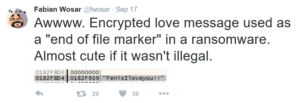A ransomware virus called FenixLocker was released and decrypted shortly after. The virus used the “[email protected]!!” file extension. The crooks behind it hoped to extort money out of users. However, the decrypter tool is bound to make that very difficult. It’s safe to assume that this “fenix” won’t be rising from the ash anytime soon.
FenixLocker Ransomware Virus – More Information
The decrypted tool for FenixLocker was developed by Fabian Wosar. As usual, the ransomware drops a note on the infected PC. The note’s name is either “Cryptolocker.txt” or “Help to decrypt.txt”
The Ransom Note:
All of your files are encrypted, to decrypt them write me to email: [email protected]
Your key:
[key code]
Files encrypted by the FenixLocker will most likely look like this: “picturename.png” becomes “[email protected]!!”.
Reports say that the ransom price for the FenixLocker is about $500. The crooks increase the sum with $250 per day after a two-day gratis period.
FenixLocker Ransomware Virus – Funny Detail
FenixLocker loves you. At least that’s what the end of file marker of the virus claims. It says “Fenixloveyou!!” message.
The “Fenixloveyou!!” Message as Shown in a tweet by Fabian:

The virus’s name comes from the message.
FenixLocker Ransomware Virus – Decrypted Tool Download
If your computer was infected by the Fenix ransomware virus you should download the decrypter tool from here. Through the efforts of ransomware researchers like Fabian, many viruses receive a decrypter.
One such virus is the Philadelphia ransomware. However, some viruses remain unencrypted for a long time.
Cerber3was released last month, and the virus is even stronger today. Many infected users have no choice but to wait for a decrypter tool. The wait can drag out for a long time. Paying the scammers seems like the easiest option. That’s rarely true. Crooks often neglect some of their “customers” and don’t bother sending a key to the locked files after they receive the ransom payment. The criminals behind Black Feather ransomware didn’t even bother creating decryption keys for infected systems. In other words, unlocking the files was impossible, even for the scammers.



